"These high-speed aircraft cruise at altitudes at which little, if any, icing occurs."
"NACA Conference on Some Problems of Aircraft Operation" 1
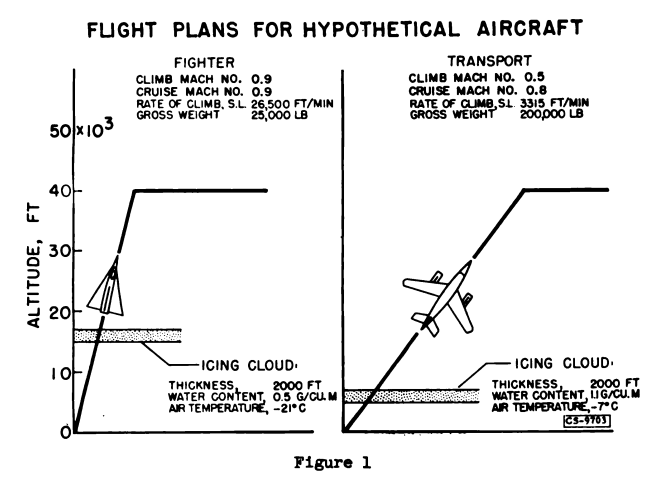
Abstract
This paper considers the performance penalty caused by icing during climb in terms of reduction in rate of climb and in range for aircraft without airframe icing protection. It should be noted that the paper is intended to show only orders of magnitude rather than absolute values.
Discussion
INTRODUCTION
This volume contains copies of the technical papers presented at the NACA Conference On Some Problems of Aircraft Operation on November 17 and 18 , 1954 at the Lewis Flight Propulsion Laboratory . A list of the conferees, who are members of the aircraft industry and the military services, is included.
The conference in 1954 had 21 presentations, two of which were on aircraft icing topics.
Here, "Some Considerations for the Need of Icing Protection of High-Speed, High-Altitude Airplanes" by Uwe Von Glahn is reproduced in its entirety.
The need for icing protection of aircraft operating at relatively low airspeeds and at altitudes less than 20,000 feet has been long recognized. These aircraft often operate long distances in continuous icing conditions. If the aircraft were not equipped with icing protection systems, long icing encounters could result in severe performance penalties and possible loss of the aircraft. For high-speed, high-altitude aircraft, however, the icing problem appears to be much less hazardous. These high-speed aircraft cruise at altitudes at which little, if any, icing occurs. The icing problem for these aircraft, therefore, is confined to climb and let-down conditions. Because of the high rates of climb and descent, the icing encounters for these aircraft are of short duration. For example, a fighter with a 20,000-foot-per-minute rate of climb would pass through a 2000-foot cloud in a matter of 6 seconds, assuming no losses due to icing. Similarly, a transport with a 3000-foot-per-minute rate of climb would require 40 seconds to climb through the same cloud.
The performance losses in icing can be minimized by the use of an icing protection system at the expense of structural complexities and installed weight. The engine and inlet must, of course, be protected to prevent engine damage by ice chunks passing into the engine. The elimination of airframe protection systems for aircraft subject only to short icing encounters appears attractive, provided the performance penalty due to icing is not excessive.
Research has been conducted at the NACA to determine the aerodynamic penalties associated with ice formations on various aircraft components. These studies were supplemented by experimental and theoretical data on where and how much water in the clouds impinges on airfoils. In addition, the time required to remove ice formations from an unheated surface by sublimation was determined experimentally. These research programs have laid the foundation for estimating the performance penalties of unprotected aircraft in icing conditions.
For purposes of illustration, two hypothetical aircrafts similar to current designs and a flight plan such as shown in figure 1 are considered.

The aircraft are assumed to climb through an icing condition to a cruise altitude of 40,000 feet. The first aircraft is a fighter of Mach 2.0 flight capability. The characteristics of the fighter are: climb and cruise speed of Mach 0.9, and an initial rate of climb at sea level of 26,500 feet per minute. The characteristics of the second aircraft, a large transport, are: climb speed of Mach 0.5 and a cruise speed of Mach 0.8, and an initial rate of climb of 3315 feet per minute.
The icing conditions and altitude of icing encounter for the flight plan were selected to provide glaze ice formations which, as will be discussed later, provide the largest aerodynamic penalties for airfoils. The ambient air temperature at which glaze ice will form on airfoil surfaces is a function of the amount of aerodynamic heating associated with the aircraft speed. The fighter with a speed of Mach 0.9 consequently has greater aerodynamic heating on the airfoil surfaces than the transport operating at Mach 0.5. The fighter, therefore, can fly through much colder icing conditions than the transport before glaze icing occurs. in appreciable quantities on the airfoil surfaces. Heavy glaze ice formation will occur on the fighter at an air temperature of -21° C and on the transport at -7° C. The altitude at which icing occurs increases with a lower air temperature. Consequently, the icing of the fighter occurs at a higher altitude (15,000 ft) than the icing of the transport (5000 ft).
Lower air temperatures are also associated with lower water content values. The fighter, therefore, passes through clouds containing an average water content value of 0.5 gram per cubic meter, while the transport passes through clouds containing 1.1 grams per cubic meter. Both aircraft are assumed to climb through a single cloud layer of 2000 feet vertical extent. The NACA statistical icing program data were used to establish these meteorological conditions. The combination of meteorological values selected are considered severe, and the probability of exceeding these combinations is less than 1 in 1000 icing encounters.
The airfoil drag penalties (fig. 2) caused by the ice formations obtained under these meteorological conditions can be determined from data obtained in the icing tunnel. These data show that section drag increase due to airfoil icing can be correlated with the total amount of ice accumulated on the airfoil and the type of ice formation. The section drag increase data fall into two general categories, that caused by light glaze and rime icing and that caused by heavy glaze icing.
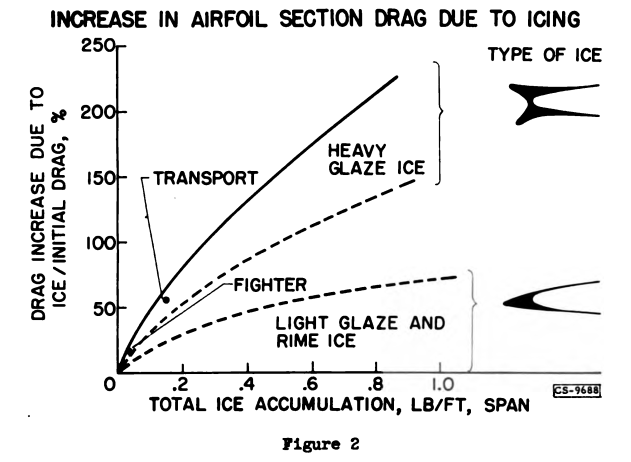
Light glaze icing results from low water contents, small droplets, and surface temperatures near freezing. Rime icing is associated primarily with low surface temperatures. Both types of icing in this category result in relatively streamlined ice formations that blend into the airfoil shape and do not add excessively to airfoil section drag. Heavy glaze icing results from high water contents, large droplets, and surface temperatures near freezing. This combination of meteorological conditions results in rough ice formations that protrude from the airfoil surface into the air stream, thereby causing large section drag losses.
For the glaze icing that occurs on the airfoils for the icing condition selected, airfoil section drag increases of 60 and 13 percent are obtained for the transport and fighter, respectively.
The significance of these section drag increases on the performance of the two hypothetical aircraft will now be considered. During the climb, the aircraft are assumed to maintain constant thrust and forward speed. Consequently, the airfoil drag change due to icing will affect only the rate of climb. Since the drag change is a function of time in the icing conditions, aircraft with high rates of climb are less affected by icing than those with low rates of climb. The loss in climb rate for both hypothetical aircraft as a function of the initial rate of climb before icing occurs is shown in figure 3.
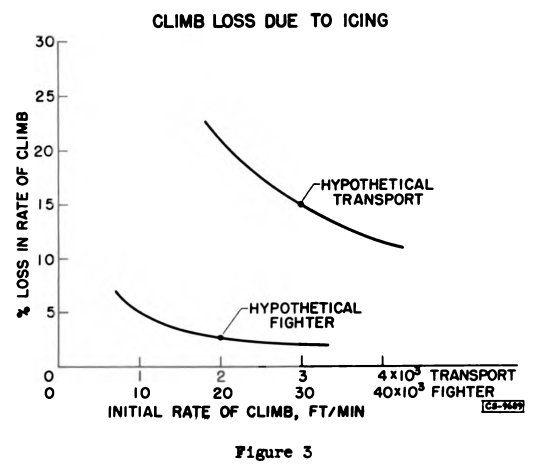
For the fighter, a loss in climb rate of less than 3 percent is obtained, while the transport suffers a climb rate loss of 15 percent. A lower initial rate of climb results in a rapid increase in the climb rate loss during icing, increase in initial rate of climb somewhat decreases the climb rate loss during icing. The change in climb rate loss with initial rate of climb is not linear because the time in icing is a function of rate of climb and airfoil drag change, both of which vary throughout the icing encounter.
In order to minimize the aircraft performance penalties, the ice accumulated during climb should be removed from the unprotected surfaces. This ice removal in the absence of an icing protection system is accomplished by a sublimation process. In this process the ice evaporatės directly from the solid to the vapor state without melting. Experimental data obtained at the NACA Lewis laboratory was used to calculate the ice sublimation rates for the two hypothetical aircraft (fig. 4). These calculated sublimation rates are shown in figure 4 as a function of altitude. At the low altitudes the sublimation rates due to the higher air temperatures are to 22 times greater than at high altitude. The sublimation rate is also greater at high speed than at low speed, as shown by the comparison of the sublimation rates for the fighter with those of the transport.
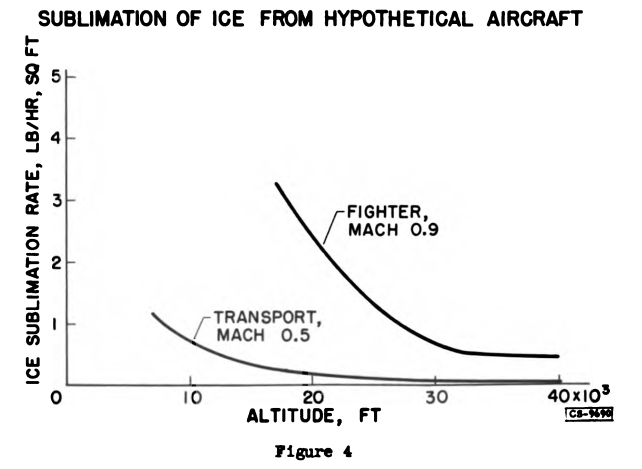
During the climb to cruise altitude (fig. 5) after the icing encounter, 55 percent of the ice on the fighter airfoil (based on maximum ice thickness) is removed by sublimation. The total time to remove all of the ice from the fighter is less than 5 minutes. For the transport, only 24 percent of the ice is removed during climb and a total sublimation time of 485 minutes is required for removal of all the ice. The long ice removal time for the transport is caused by the large percentage of ice left on the surfaces after the climb and the low ice sublimation rates.
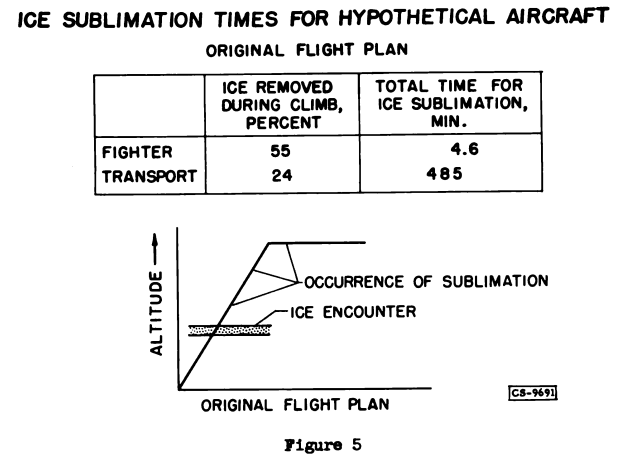
The longer time required to reach cruise altitude and the loss in forward speed caused by an icing encounter result in a decrease in the aircraft range or a depletion of the fuel reserves. The performance decrease in icing is considered negligible for the fighter because of the small effect of the airfoil drag penalties on rate of climb, speed, and range. For the original flight plan of the transport, the forward speed is decreased by 5.5 percent at the start of cruise at 40,000 feet. This loss in forward speed is gradually reduced as the ice is removed during cruise. The deterioration in performance due to airfoil icing causes a reduction in range for the transport. For an initial range of 2200 miles, the range after an icing encounter during climb is reduced by 5 percent, while for an initial range of 4200 miles, the range after an icing encounter is reduced by 3 percent.
The higher sublimation rates at low altitudes suggest the possibility of an alternate flight plan (fig. 6) to reduce the time required to sublimate the ice formations and thereby reduce the loss in range. With this flight plan, a change to level flight is made immediately after emerging out of the icing condition and flying horizontally until all the ice has been sublimated. The climb to the cruise altitude can then be continued free of ice. Since the fuel rate will be increased by operating at low altitude, the feasibility of this flight plan depends on the balancing of the decreased range loss resulting from the lower sublimation time with the range loss resulting from the increased fuel rate during this time. With the alternate flight plan the sublimation time for the fighter is decreased from about 5 minutes to 1 minute. For the transport the sublimation time with alternate flight plan is substantially reduced to only 23 minutes compared with the 485 minutes required with the original flight plan. If the speed in level flight for the transport is increased from Mach 0.5 to Mach 0.65, the time to remove the ice is further reduced to 12 minutes because of the increased sublimation rate at this higher speed. In the latter case if the fuel rate at low altitude exceeds that at high altitude by a factor of approximately 2.0, no benefit is achieved by sublimation at low altitude, since the decreased range loss due to a lower sublimation time is offset by the increased fuel rate at the lower altitude. Because the fuel rate for jet engines at low altitude is of the order of 4 times that at high altitude, the alternate flight plan does not appear feasible.
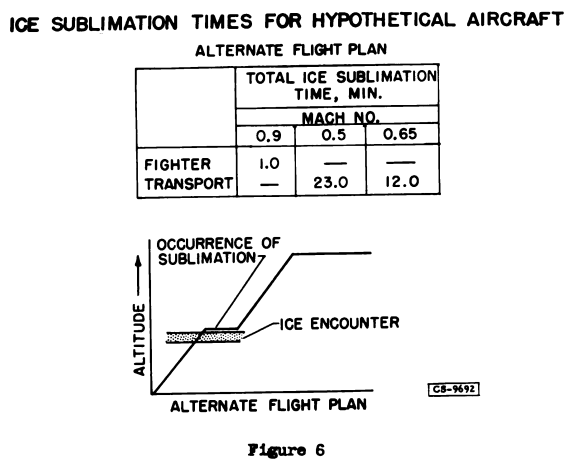
For the aircraft considered, it appears that the let-down condition with a possible go-around in icing conditions poses the greatest icing problem. Under such conditions the possibility exists that stability and control problems could be encountered. No problem is anticipated from a possible deterioration of lift and drag increase due to icing, since sufficient thrust is available to counteract these factors. The type of ice formations that a fighter might encounter during an 8-minute go-around in icing is shown in figure 7 and illustrates the size of the glaze ice formations that could be accumulated. The maximum thickness of the ice formation near the leading edge is over 1 inch. The effect of such ice formations on the control effectiveness and aircraft stability during the let-down and landing operation has not been assessed.
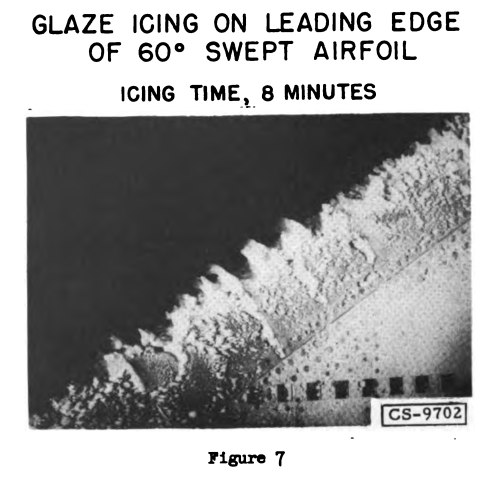
Conclusions
A program to appraise the control problem associated with airfoil icing is contemplated for the near future. If the results of this program indicate that airfoil icing does not affect aircraft control, high performance fighters with flight plans such as assumed herein will require no airframe icing protection. If, on the other hand, an aircraft control problem due to airfoil icing does exist, a limited protection system that will protect the portion of the wing ahead of the control surfaces may be required for let-down through icing conditions. Such a limited icing protection system does not require the structural complexities of full protection systems. A limited icing protection system also would not impose large installed weights nor appreciably penalize the aircraft performance.
The arguments presented above have largely been followed. Many high-performance, "fighter" type aircraft have only limited ice protection, largely for air data probes, and some engine inlet components. Depending on the intended use, some mission profiles may involve long duration hold and low speed loitering at altitudes where icing is more likely, even if the aircraft is capable of high-speed, high-altitude operations. In those cases, more complete ice protection may be required.
Notes
-
von Glahn, Uwe H.: "Some Considerations for the Need of Icing Protection of High-Speed, High-Altitude Airplanes", NACA Conference on Some Problems of Aircraft Operation. NASA-TM-82265, 1954. books.google.com ↩